All 2,545 Great Western Railway workers who died during the war to be named on special train.

Great Western Railway will mark 100 years since the end of the Great War by unveiling a very special train prior to a remembrance service for fallen railway workers at Paddington Station on Friday 9 November.
Enjoy more Heritage Railway reading in the four-weekly magazine.
Click here to subscribe & save.
The Intercity Express Train will feature the names of all 2,545 men who worked for the GWR and died during the war, and will be welcomed into London Paddington by relatives of those killed.
The train will also be named after two of those who died, Flight Sub-Lieutenant Harold Day, DSC, the only railway man to become a flying ace and Lance-Corporal Allan Leonard Lewis, VC, whose name has historically been omitted from the GWR Roll of Honour.
Present for the ceremony will be relatives of both Harold Day and Allan Leonard Lewis, along with relatives for four other GWR men:
- Ernest Rudd who worked at Southall and was killed on the first day of the Somme. (Relatives in Somerset)
- Edgar Norton who worked at the Swindon Railway works and was killed at the end of the Somme. (Relatives in Swindon – Great Niece)
- William Hannaford who worked at Plymouth and was in the Devonshire Regiment killed in 1917 the day before his younger brother was also killed. (Relative in Newton Abbott – Great Niece)
- Harry Western who worked at Exeter and was killed at the Battle of Arras. His Great Niece works for GWR today. (Based at Exeter – Great Niece)
To recognise all of lives lost the full train is being given a distinctive design stretching over both sides of the nine carriages including the driving cabs at either end of the Intercity Express Train. The Roll of Honour features detail of where they worked for the company, their rank, regiment, where they were killed and where they are either remembered or buried. From the 2,545 names, one hundred will also feature in more detail on the train, including pictures and background stories.
Great Western Railway Deputy Managing Director Matthew Golton said:
“The role of the railway in helping mobilise the country and sustain the war effort was immense. Over 25,000 employees of GWR volunteered to serve, a third of the company at the time. It is therefore fitting that as we remember all those who took part in this terrible conflict, we honour those of the GWR who fell.”
Those being remembered worked in all areas of the company; engineers, labourers, solicitors, carriage cleaners and apprentices from across the GWR network. At the time the network stretched from Paddington to Penzance, and as far north as Liverpool, Manchester, Chester, Birmingham and Wolverhampton.
Other Soldiers featured are:
- William and Ernest Leggett.0 Ernest cradled his dying brother before being killed just three months later.
- William Saloway who was serving on board HMS Hampshire when it hit a mine killing nearly all on board including Field Marshall Lord Kitchener.
- Joseph Godwin, served with the 10th West Yorkshire Regiment who suffered the most casualties on the first day of the Somme.
- Edwin Gomm, the first GWR man to be killed.
- Thomas Cruise, the last GWR man to be killed.
The train will be welcomed into Platform 1 at 10:30 by the Wessex Male Choir before a short ceremony which will include family members of those being remembered.
After the ceremony, the train will enter passenger service as the 11:36 from Paddington to Cheltenham Spa. The train will go on to serve across the Great Western mainline towards South Wales, Bristol, and the North and South Cotswolds.
Who was from my area?
Ernest Henry John Rudd
Goods Clerk at Southall, a Lance Sergeant in the 1/8th Middlesex Regiment. Awarded the Military Medal for carrying out essential work under fire, and carrying a badly wounded man back to the trench. He was killed in action aged 24 during an attack at Gommecourt on the first day of the Battle of the Somme. He has no known grave and is commemorated at the Thiepval Memorial.
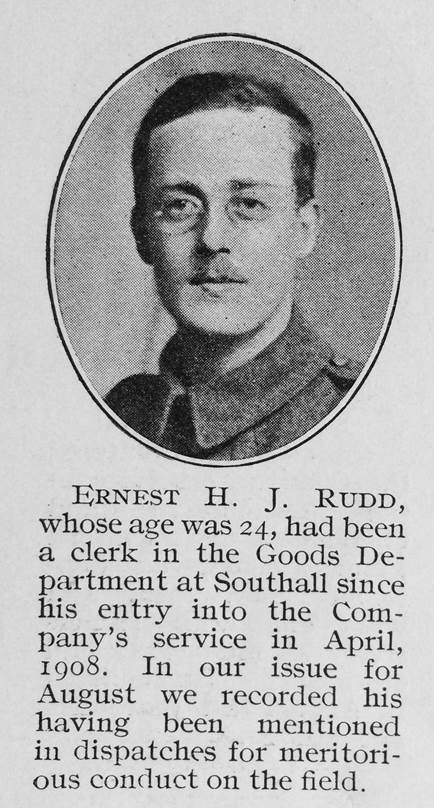
Great niece Claire Rudd said: “Discovering he was killed on the first day of the bloodiest battle of the war has been difficult to comprehend. Reading his citation is incredibly moving, hearing of his bravery.”
Edgar George Norton
Wagon Painter at the Swindon works, served as a Private in the 2nd Battalion Coldstream Guards. After a successful assault on German lines they came under heavy and sustained shell fire. When the battalion was relieved they had lost 456 men either killed, wounded or missing. Edgar was killed on the 16 September 1916, aged 31 and is buried in Seville Wood Cemetery.
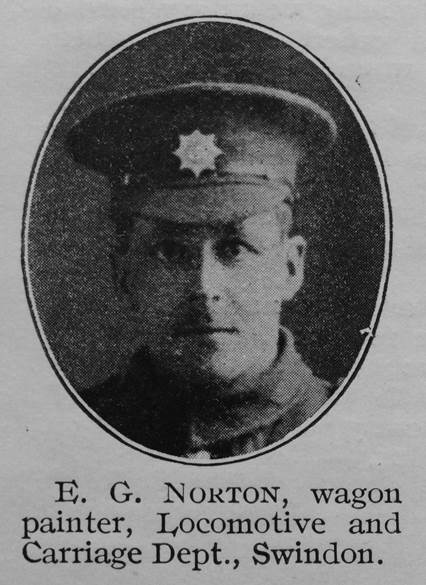
Great niece Jean Moulton said: “I have always been so very proud of Great Uncle Edgar. This is incredibly moving for me, to now know that his name and picture is being carried on a train which will go right past the place he worked.”
William Henry Hannaford
Rail Motor Conductor at Plymouth, served as a Sergeant in the 5th Devonshire Regiment. He was posted to the 10th Royal Warwickshire Regiment in March 1918, but weeks later was killed on the 10th April 1918 aged 25. He has no known grave and is commemorated at the Tyne Cot Memorial. His younger brother, Albert, was killed a day later, aged 19.
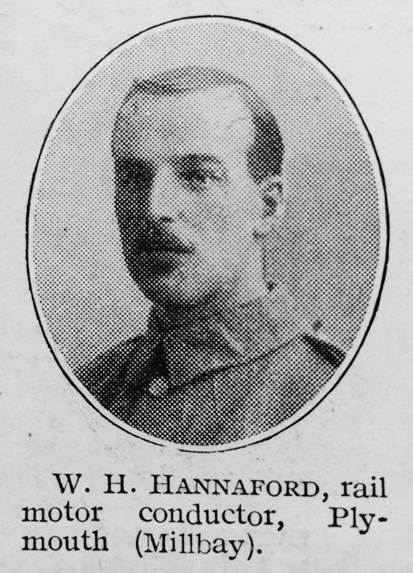
Great niece Sandra Gittins said: “Finding out about him was the inspiration to research the GWR further. The role of the GWR in the build up to World War 1, what it achieved as a company; and what its employees achieved for this country is truly staggering.”
Harry Charles Western
Engine Cleaner at Exeter, he was a Private in the 8th Devonshire Regiment. In April 1917 during the Battle of Arras, the 8th and 9th Battalions attacked Ecoust with great success and although casualties were light, Harry was killed on 2nd April 1917 aged 21. He has no known grave and is commemorated at the Arras Memorial.
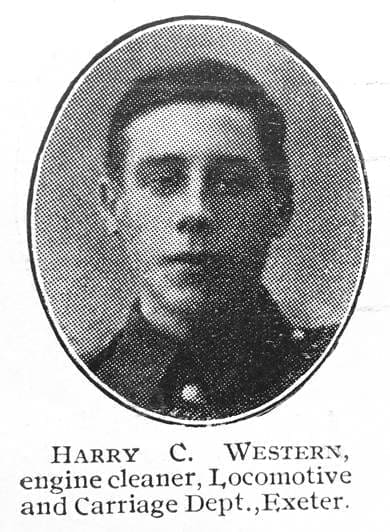
Great niece Jane Brook, who is a present GWR employee at Exeter, said: “I remember clearly the day when I found my Great Uncle’s name on the GWR Roll of Honour at the very place I now work. To have a train with his name on is amazing, I know he would be proud to see how the company is recognising him and the other fallen.”
Flight Sub-Lieutenant Harold Day D.S.C.
Born in Abergavenny, he joined the GWR as a Premium Apprentice at the Swindon Works. In January 1917 he joined the Royal Naval Air Service, just prior to his 19th birthday. His ability as a fighter pilot was proved with his first victory in August that year and between December 1917 and his death in February 1918 his status as an Ace was guaranteed with a further 10 victories. He was awarded the Distinguished Service Cross.
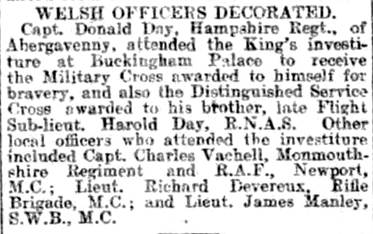
Immediately after his last victory on the 5 February 1918, his Sopwith Camel N6379 collapsed in the air while diving on enemy aircraft at excessive speed, and crashed at Harnes. German fighter pilot, Gunter Schuster, was quick to claim Harold Day as his victory. Flight Sub-Lieut Day is buried at St Mary’s A.D.S. Cemetery, Haisnes, France.
Great nephew Nicholas Blake said: “Our memories of Harold are limited to the recollections of our grandparents, who spoke of him with fondness and sadness. His ability as a pilot is clear and he was daring and courageous without question. We are thrilled that his day will be associated with the company he worked for in this way.”
Lance-Corporal Allan Leonard Lewis V.C.
Although Allan Lewis was born Whitney-on-Wye, one of nine children, he had left school at thirteen to work on the land eventually becoming a gardener at Truscoed House near Llandeilo in West Wales.
Lewis always enjoyed working with machines though and this led to him becoming an employee of the Great Western Railway. He moved to Neath and after a period as a conductor he drove a GWR bus on the Pontardawe route.
Lewis joined the army in Neath in March 1915. On 18 September 1918 at Rossnoy, near Lempire, France, Lance-Corporal Lewis was in command of a section on the right of the attacking line held up by intense machine-gun fire. He saw that two guns were enfilading the line and crawled forward alone, successfully bombed the guns and by rifle fire made the whole team surrender. On 21 September he rushed his company through the enemy barrage, but was killed while getting his men under cover from heavy machine-gun fire. Why he is not remembered on the existing role of honour is a mystery, but theories abound. (Relative in Hereford – Hay area)
Great Niece Dawn Lewis said: “Why Allan was never included on the GWR Roll of Honour is a mystery, but I am thrilled that his extraordinary valour is now commemorated in such an spectacular and moving way.”
William Stephen Leggett.
Coach Body Maker in No 19 Shop at the Swindon Works, a Lance Corporal in the 1st Wiltshire Regiment with his younger brother Ernest. Involved in some of the fiercest fighting around Hooge, he was fatally wounded on 16 June 1915 aged 22, while retreating back to the trench. His brother cradled him as he died. He has no known grave and is commemorated at the Menin Gate.
Ernest George Leggett.
Fitter in No 3 Shop at the Swindon Works, a Lance Corporal in the 1st Wiltshire Regiment. On his brother’s death, Ernest wrote to his mother, ‘…dear old Bill got hit…I was very soon with him and stayed by his side until he passed away.’ Ernest was killed, aged 21, during heavy bombardment on 3 September 1915. He is commemorated with his brother at the Menin Gate.
William Luke Saloway.
Son of a GWR Foreman, he worked in the Loco and Carriage Department at the Swindon Works. A Signal Boy on board HMS Hampshire, when it was carrying Field Marshall Lord Kitchener to Russia. It is believed to have struck a mine with the loss of 737 crew and passengers, 26 survived. William was 17 when he was lost and is commemorated at the Portsmouth Naval Memorial.
Edwin Hubert Gomm.
Worked in the Loco and Carriage Department at Southall, a Private in the 4th Royal Fusiliers. Wounded during the German attack on Mons and possibly one of those that had to be left on the battlefield. His death is recorded as 23rd August 1914, aged 35. The first GWR man to be killed in the war and is commemorated on the La Ferete-Sous-Jouarre Memorial.
Charles Thomas Cruise.
Porter in the Traffic Department at Birmingham, he was a Private in the 45th Royal Fusiliers. He was killed in action while fighting on the Eastern Front on 10 August 1919 aged 19 and is commemorated on the Archangel Memorial in Russia. His death came nine months after the Armistice had been signed and he was the last GWR man to be killed in action.
Joseph William Godwin.
Hydraulic Department Labourer at Hockley, he was a Corporal in the 10th West Yorkshire Regiment. This battalion suffered the heaviest losses of any in the British Army on the first day of the Battle of the Somme, with 27 officers and 750 other ranks killed. Out of the 900 men only 125 survived the day. He was 37 and is commemorated at the Thiepval Memorial.
Advert
 Enjoy more Heritage Railway reading in the four-weekly magazine. Click here to subscribe.
Enjoy more Heritage Railway reading in the four-weekly magazine. Click here to subscribe.











